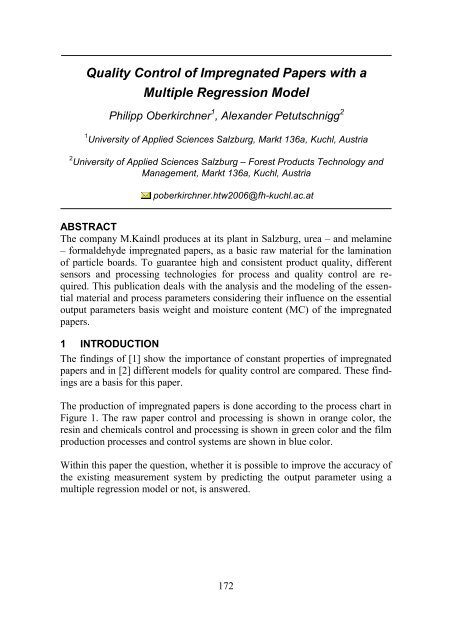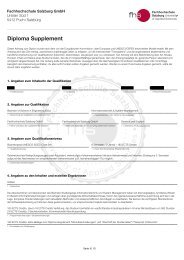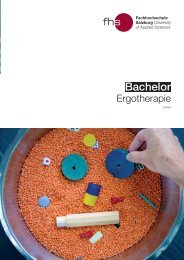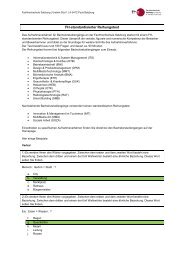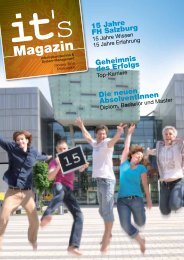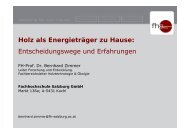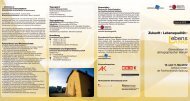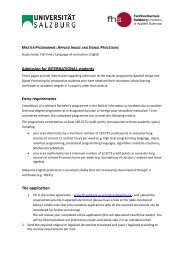Quality Control of Impregnated Papers with a Multiple Regression ...
Quality Control of Impregnated Papers with a Multiple Regression ...
Quality Control of Impregnated Papers with a Multiple Regression ...
- No tags were found...
Create successful ePaper yourself
Turn your PDF publications into a flip-book with our unique Google optimized e-Paper software.
<strong>Quality</strong> <strong>Control</strong> <strong>of</strong> <strong>Impregnated</strong> <strong>Papers</strong> <strong>with</strong> a<strong>Multiple</strong> <strong>Regression</strong> ModelPhilipp Oberkirchner 1 , Alexander Petutschnigg 21 University <strong>of</strong> Applied Sciences Salzburg, Markt 136a, Kuchl, Austria2 University <strong>of</strong> Applied Sciences Salzburg Forest Products Technology andManagement, Markt 136a, Kuchl, Austriapoberkirchner.htw2006@fh-kuchl.ac.atABSTRACTThe company M.Kaindl produces at its plant in Salzburg, urea and melamine formaldehyde impregnated papers, as a basic raw material for the lamination<strong>of</strong> particle boards. To guarantee high and consistent product quality, differentsensors and processing technologies for process and quality control are required.This publication deals <strong>with</strong> the analysis and the modeling <strong>of</strong> the essentialmaterial and process parameters considering their influence on the essentialoutput parameters basis weight and moisture content (MC) <strong>of</strong> the impregnatedpapers.1 INTRODUCTIONThe findings <strong>of</strong> [1] show the importance <strong>of</strong> constant properties <strong>of</strong> impregnatedpapers and in [2] different models for quality control are compared. These findingsare a basis for this paper.The production <strong>of</strong> impregnated papers is done according to the process chart inFigure 1. The raw paper control and processing is shown in orange color, theresin and chemicals control and processing is shown in green color and the filmproduction processes and control systems are shown in blue color.Within this paper the question, whether it is possible to improve the accuracy <strong>of</strong>the existing measurement system by predicting the output parameter using amultiple regression model or not, is answered.172
Figure 1. Process chart <strong>of</strong> <strong>Impregnated</strong> paper production2 METHODS AND RESULTSThe modeling was done in two steps. In the first step data were collected over atime period <strong>of</strong> six weeks during the current production process. In this processautomated measureable data were collected in the facility and additional datafrom possible predictors, which have been analyzed in a laboratory, were alsocollected. On the basis <strong>of</strong> the collected data, predictors that were statisticallysignificant were identified using multiple linear regression analysis.In the second step the determined significant output parameters were collectedover a time period <strong>of</strong> six weeks and a multiple linear regression (MLR) modelto verify the results <strong>of</strong> the first experimental model was developed. For theMLR models only automated statistically significant parameters were used toensure a high and steady quality <strong>of</strong> the final product. In Figure 2 the improvementsin quality control are shown for the two optimized models. In Table 1 allmodel parameters are shown, as well as the model summary.173
Table 1. Model Parameters and Model Summary <strong>of</strong> the two ModelsModel 1 Model 2Model ParametersModel ParametersB Std Err t Sig B Std Err t SigConstant 7,084 0,51 12,19 ,000 5,257 0,25 20,623 ,000b1 0,046 0,006 7,588 ,000 - 0,001 -5,441 ,000b2 -0,029 0,003 -8,875 ,0000,0330070,003 10,466 ,000b3 -0,73 0,022 -3,265 ,002 -0,04 0,019 -2,128 ,035b4 -0,008 0,001 7,546 ,000Model SummaryR 0,92 0,786R2 0,851 0,618Adj. R2 0,838 0,610Std Err. <strong>of</strong>Estimates0,16926 0,34261Model SummaryTraining DataValidation DataFigure 2. Improvements in <strong>Quality</strong> control174
REFERENCES[1] Kandelbauer A., Teischinger A. On the warping behavior <strong>of</strong>particleboards coated <strong>with</strong> melamine formaldehyde resin impregnatedpapersEur. J. Wood Prod., 10. April 2009, S. 367 378.[2] Young T.M., Shaffer L.B., Guess F.M., Bensmail H., Leon R.V. (2008):A Comparison <strong>of</strong> multiple linear regression and quantile regression formodeling the internal bond <strong>of</strong> medium density fiberboard. In: ForestProducts Journal Vol. 58. No. 4, April 2008, S. 39 - 48.[3] André N., Cho H.-W., Baek S.H., Jeong M.-K., Young T.M. (2008): Prediction<strong>of</strong> internal bond strength in a medium density fiberboard processusing multivariate statistical methods and variable selection. Wood Scienceand Technology 42(7): 521-534.[4] Bernardy G., Scherff B. (1998): Saving costs <strong>with</strong> process control engineeringand statistical process optimisation: uses for production managers,technologists and operators. In: Proceedings <strong>of</strong> the 2 nd European PanelProducts Symposium (EPPS):95-106.[5] Cook D.F., Chiu C.C. (1997): Predicting the internal bond strength <strong>of</strong>particleboard utilizing a radial basis function neural network. Engng Applic.Artif. lntel. 10(2):171-177.[6] Young T.M., Guess F.M. (2002): Developing and mining higher qualityinformation in automated relational databases for forest products manufacture.International Journal <strong>of</strong> Reliability and Application 3(4):155-164.[7] Young T.M., André N., Huber CW. (2004): Predictive modeling <strong>of</strong> theinternal bond <strong>of</strong> MDF using genetic algorithms <strong>with</strong> distributed data fusion.In: Proceedings <strong>of</strong> the 8 th European Panel Products Symposium:45-59.175
Alfred Teischinger, Marius C. Barbu, Manfred Dunky, DavidHarper, Gerfried Jungmeier, Holger Militz,Maurizio Musso, Alexander Petutschnigg, Antonio Pizzi,Stefanie Wieland, Timothy M. Young (Eds.)Processing Technologies forthe Forest andBiobased Products IndustriesPTF BPI 2010. Salzburg University <strong>of</strong> Applied SciencesKuchl/Austria


